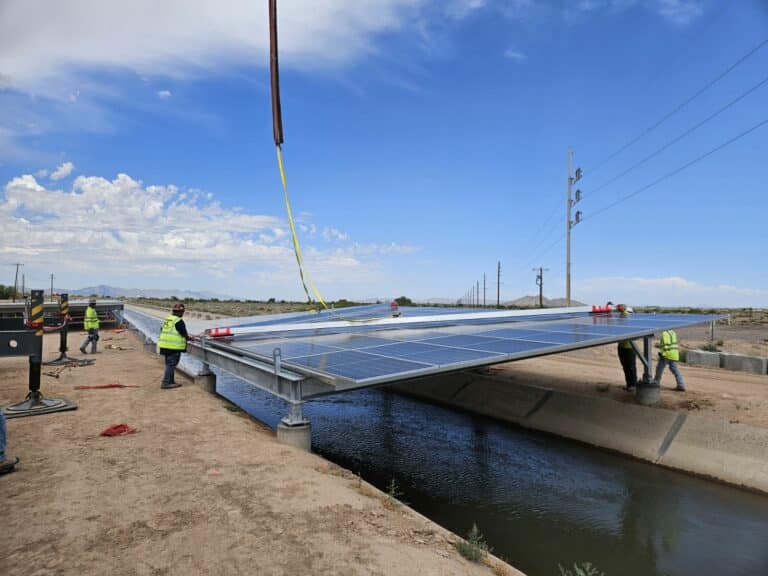Water scarcity is a critical issue in many regions, with evaporation from open water sources like canals contributing significantly to the problem. Addressing this challenge, Miami Wiipica LLC, with support from Miami Federal, has undertaken the groundbreaking Solar Over Canal project. This initiative not only serves as a “Green Initiative” by harnessing solar energy but also aims to reduce water loss by shading the canals. The project represents a pioneering effort to combat water evaporation while contributing to sustainable energy production.
Key Takeaways:
- Shading canals in Gila River cuts water loss due to evaporation, offering a model for other arid regions.
- Combining solar energy with water conservation, this project tackles multiple environmental challenges.
- The project’s precise engineering ensures long-term efficiency and durability.
- A 5-year study will assess the project’s success and potential for global replication.
Revolutionizing Water Conservation in Gila River
The Gila River region, like many arid areas, faces severe water scarcity challenges. Evaporation from canals and reservoirs exacerbates the problem, leading to significant water loss that could otherwise be used for agriculture, community needs, and ecological preservation. Studies on water management in arid regions, including areas similar to Gila River, indicate that open water sources like canals can experience significant water loss due to evaporation, sometimes accounting for a substantial percentage depending on local climate conditions. The Solar Over Canal project is a revolutionary approach to addressing this issue head-on.
By shading the canals with solar panels, the project reduces the amount of water lost to evaporation—a common issue in the Gila River area. This approach not only conserves a vital resource but also generates renewable energy, turning a challenge into an opportunity. The Solar Over Canal project is a prime example of how innovative solutions can be applied to pressing environmental problems, making a significant impact on both local communities and broader ecosystems.
The implications of this project are far-reaching. If successful, this model can be replicated in other regions facing similar challenges, offering a sustainable solution that integrates water conservation with renewable energy production.

The Solar Over Canal Project: A Groundbreaking “Green Initiative”
The Solar Over Canal project is more than just a water conservation effort; it’s a significant “Green Initiative” that aligns with global goals for sustainability and environmental protection. The primary goal of the project is to shade the water in the canals to decrease evaporation, thereby conserving up to 60% of the water that would otherwise be lost. This aligns with research showing that shading water bodies can reduce evaporation by 30-60%. However, the project’s impact extends beyond water conservation.
By installing solar panels over the canals, the project generates electricity that benefits the local community, reducing reliance on non-renewable energy sources. Solar energy has proven to be a critical component of sustainable development, with studies indicating that solar installations can reduce greenhouse gas emissions by approximately 30 million tons of CO2. This dual-purpose approach maximizes the utility of the infrastructure, providing both environmental and economic benefits.
Moreover, the Solar Over Canal project supports the community by offering a sustainable solution that addresses immediate water scarcity concerns while also contributing to long-term energy security. It sets a precedent for other regions to follow, demonstrating how green initiatives can be both practical and impactful.

Engineering Excellence: Constructing a Sustainable Future
The success of the Solar Over Canal project is rooted in the engineering excellence that went into its construction. The project involved the installation of 3,000 linear feet of structural steel and solar panels, meticulously designed and executed to meet the project’s goals. The construction was completed on time and within budget, a testament to the efficiency and expertise of the Miami Wiipica LLC and Miami Federal teams.
A key aspect of the project was the testing of both domestic and foreign solar panels. This was done to determine which panels offer the best solution for longevity and sun-to-electric power conversion. According to the Center for Sustainable Systems, the efficiency of solar panels can vary between 17-20% depending on the technology used, which can significantly impact the overall energy output. By evaluating different types of solar panels, the project aims to identify the most effective and durable options, ensuring that the infrastructure remains functional and efficient for years to come.
The engineering work didn’t just stop at construction. The project also includes a 5-year study period during which the performance of the solar panels and the impact on water conservation will be closely monitored. This study will provide valuable data that can inform future projects, enabling continuous improvement and innovation.

Future Impact: Evaluating the Success of Solar Over Canal
The Solar Over Canal project is not just a one-time initiative; it’s a forward-thinking solution with long-term implications. Over the next five years, the project will be closely studied to evaluate its effectiveness in reducing water evaporation and enhancing solar energy efficiency. This evaluation will consider various factors, including the durability of the solar panels, the amount of water conserved, and the overall impact on the community.
The results of this study will be crucial in determining the future of similar projects. If the Solar Over Canal project proves successful, it could serve as a model for other regions facing water scarcity and energy challenges. The potential for scaling this project is significant, with the possibility of implementing similar solutions in other parts of the country or even globally.
Moreover, the ongoing engineering work will focus on refining and expanding the project, ensuring that it remains at the cutting edge of sustainable development. Miami Wiipica LLC and Miami Federal are committed to continuous innovation, always seeking new ways to improve the project and maximize its benefits.
A Blueprint for Global Sustainability: The Impact and Promise of the Solar Over Canal Project
The Solar Over Canal project is a pioneering effort that reflects Miami Wiipica LLC and Miami Federal’s commitment to innovative, sustainable solutions. As the project progresses, it will not only benefit the Gila River community but also serve as a blueprint for addressing similar challenges around the world. This initiative exemplifies the kind of forward-thinking approach that is essential in today’s rapidly changing environmental landscape.
Join us in leading the way toward a more sustainable future. Learn more about how innovative projects like the Solar Over Canal can benefit your community and contribute to global environmental efforts. Contact Miami Federal today to discover how we can collaborate on projects that make a lasting impact.








